Club América
Club de Fútbol América S.A. de C.V., commonly known as Club América or simply América, is a professional football club based in Mexico City, Mexico. Nicknamed Las Águilas (The Eagles), it competes in Liga MX, the top tier of Mexican football. The club was founded in 1916, and since 1959 has been owned by media company Grupo Televisa.[5] The team plays its home games at the Estadio Azteca, the largest stadium in Mexico and Latin America, and the seventh largest association football-specific stadium in the world.[6][7][8]
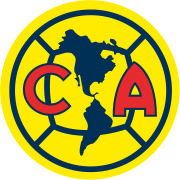 | |||
| Full name | Club de Fútbol América S.A. de C.V.[1] | ||
|---|---|---|---|
| Nickname(s) | Las Águilas (The Eagles)[2] Los Azul-Cremas (The Blue-Creams)[3] Los Millonetas (The Millionaires)[3] | ||
| Short name | AME, CFA | ||
| Founded | 12 October 1916 | ||
| Ground | Estadio Azteca | ||
| Capacity | 87,523[4] | ||
| Owner | Grupo Televisa | ||
| Chairman | Emilio Azcárraga Jean | ||
| Manager | Miguel Herrera | ||
| League | Liga MX | ||
| Clausura 2020 | 4th | ||
| Website | Club website | ||
|
| |||
The club has a long-standing rivalry with Guadalajara, as both are the most successful and most popular clubs in the country, and are the only clubs to have never been relegated to the second division.[9] Matches between them are known as El Súper Clásico,[10] considered to be the biggest rivalry in Mexico, and one of the biggest in the world.[11][12][13] América also play local derbies against Cruz Azul and Club Universidad Nacional.
The club has won a record thirteen league titles, as well as a record six Copa México titles, and six Campeón de Campeones cups. In international competitions, América has won ten FIFA recognized club trophies, the most for a club from the CONCACAF region. It has won a record seven CONCACAF Champions Cup/Champions League titles, two Copa Interamericana cups and one CONCACAF Giants Cup.[14][15][16]
History
Foundation
By 1916 football was already a popular sport in Mexico, particularly amongst college students in Mexico City. College students from Colegio Mascarones and Colegio Marista de la Perpetua formed two football teams with the names Récord and Colón. On 12 October 1916, the two squads decided to consolidate to make a more competitive squad. Many names were considered for this new squad, and team player Pedro "Cheto" Quintanilla suggested the name "América", since they had formed the team on Columbus Day (Día del descubrimiento de América). The players agreed and soon designed a crest which had the map of the Americas centered with a 'C' for "Club" on the left and an 'A' for "América" on the right. In deciding the team's colors, Rafael Garza Gutiérrez got a pair of his father's navy blue trousers and a yellow shirt and it was decided amongst the group that those would be the club's kit and colors.[17]
In 1916, Club América had to prove itself to the Mexican Football League, then-known as the Primera Fuerza. At the time, América was the only club in Mexico City with Mexican-born players. Necaxa, Atlante, Real Club España, Germania, and Asturias were already members of the Liga Mayor de la Ciudad. América's acceptance into the league rested on three games they had to win. América won two games, tied the third and were accepted.
In 1919, the team changed its name to Club Unión, though the club returned to the name América the following year.[18]
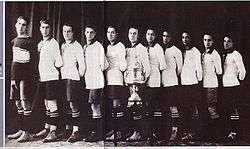
América won their first Primera Fuerza title in the 1924–25 season, being crowned champions after defeating Asturias 1–0 in the deciding match.[20] América would win the Primera Fuerza three more times, all of them back-to-back.[21] In 1926, América became the first Mexican club to play outside of Mexico.[18] Aside from broadening their horizons, Club América, along with Atlante petitioned to reduce the number of foreign players in the league. Shortly after the Mexican Football Federation was formed in 1928, Rafael Garza Gutiérrez was designated as the head coach of the Mexico national team. Most of the national team squad that participated in the 1928 Summer Olympics and 1930 World Cup consisted of players from Club América.[22]
1940–1969
Until 1942, Mexico had several leagues, although the league in Mexico City was considered the most developed. In 1942–43, the first National League was established and it was known as the Liga Mayor (Major League). Club América had declined from its then-prime of the 1920s and 1930s: aging players, diminishing financial resources, and resulting lack of interest made the team a bottom-feeder at the start of the beginning stage of the professional era7.
It was also during this time that the rivalry with Guadalajara was born; especially during the 1945–1946 season when Guadalajara beat América by 6–4 and 4–2 scorelines. The 1951–1952 season saw América finish in 11th place out of 12, with a 3-point-advantage over Veracruz, who were relegated. In 1954 América defeated rivals Guadalajara on penalties after a 0–0 draw in the Copa México final, thus winning their first league cup.[23]
In 1956, the club was sold to soft drink manufacturer Jarritos. The new owner was trying to build upon the club's National Cup titles in 1954 and 1955 against Guadalajara.[24] During the 1954–55 season América won their first Campeón de Campeones championship, defeating Zacatepec 3–2.[25] The owner failed to build upon previous success and on 22 July 1959, Emilio Azcárraga Milmo, owner of Telesistema Mexicano, bought América from Isaac Bessudo.[26] Following the acquisition, Azcárraga told his players, "I do not know much about football, but I do know a lot about business, and this, gentlemen, will be a business."[27]
The 1959–1960 season saw América reach second place in the league, behind Guadalajara. On 21 April 1964, at the Estadio Olímpico Universitario, the team, now coached by Alejandro Scopelli, defeated Monterrey 6–5 in the final match of the Copa México. During the match Alfonso Portugal scored five of América's six; José González scored the other goal to win the championship.[28]
On 7 May 1965, América regained the Mexican "Copa" championship after a 4–0 victory over Morelia at the Estadio Olímpico Universitario. The goals were scored by Javier Fragoso and Vavá, each scoring twice.[29]
1970s
After Mexico hosted the 1970 FIFA World Cup, the league tournament format was changed in response to the championship's disputed winners, hence the Liguilla (play-offs) format was started. The first play-off final was in 1971 between Toluca and América, leaders of Groups 1 and 2, respectively. After a 0–0 draw in Toluca, América obtained their second league title after winning the second-leg 2–0 at the Estadio Azteca.[30] The following season saw América eliminated from the playoffs by Cruz Azul. América would defeat Cruz Azul the 1973 Copa México final.[31] A few years followed in which América did not qualify for the playoffs. They finished in first place during the 1975–1976 season, and defeated Tecos UAG and Union de Curtidores in the quarter-finals and semi-finals to reach the final against Universidad de Guadalajara. América won the championship after beating UDG in the Jalisco Stadium 3–0 and 1–0 at the Estadio Azteca.[32] They also won the Campeón de Campeones title by beating Tigres UANL 2–0.[33]
In 1977, América participated in their first Copa Interamericana, playing against Argentine club Boca Juniors, winners of the 1977 Copa Libertadores. After losing the first-leg and winning the second, América would win the championship in a playoff match in 1978 by a score of 2–1 after extra-time, with a last second free-kick goal by midfielder Carlos Reinoso.[34] América became the first team from Mexico and from the CONCACAF region to win the competition. América also became the first confederation side to earn the "double" in a single year as it won the delayed 1977 CONCACAF Champions' Cup.[35]
1980s
The 1980s are generally considered América's "golden decade".[36] During this period, América won the league title five times, including three consecutive titles; the 1983–84 season, the 1984–85 season,[37] the Prode-85 tournament, the 1987–88 and 1988–89 seasons.[38] They also won the Mexican Super Cup twice, in 1987–88 and 1988–89,[39] as well as the 1987 CONCACAF Champions' Cup.
The 1983–1984 season saw América reach the top of the table and reach the finals, where they would face arch-rivals Guadalajara, who the previous season had eliminated América in the semi-finals. Following a 2–2 draw at the Estadio Jalisco, América defeated Guadalajara in the Azteca Stadium 3–1, and a 5–3 aggregate score.[40] To date, it is the only match between these two teams in the league finals, though they would face each other in other phases of the playoffs. The series has since been dubbed the "Final del Siglo" ("Final of the Century").[41][42] The following season América once again reached the finals, this time against city-rivals Pumas UNAM. After two draws in both the Azteca Stadium and the Mexico '68 Stadium, the last game was played in the Estadio Corregidora in Querétaro, where Daniel Brailovsky secured the championship for América by scoring two goals with the final score of 3–1.[43]
Due to Mexico hosting the 1986 World Cup and stadium and infrastructure preparations, the tournament was split in two short tournaments: Prode-85 and Mexico-86. América clinched the top of their group in the Prode-85 and defeated Universidad de Guadalajara and Atlante (which was rescheduled following the earthquake suffered in Mexico City)[44] to reach the final, where they faced Jaibos Tampico Madero. The game in Tampico was a 4–1 victory for Tampico, but at the Azteca Stadium, América beat Tampico Madero 4–0 to win the championship.[45]
For the 1987–88 season, América met UNAM in the final, in a replay of the 1985 final. They defeated UNAM by an aggregate score of 4–2.[46] The following season, América once again reached the league final and faced Cruz Azul, which was the first time the two clubs met in the final since 1972. The first-leg finished in a 3–2 victory for América. A 2–2 draw in the second-leg meant América won the championship by a 5–4 aggregate score.[47]
1990s
During the 1990s, América only managed to win the CONCACAF Champions' Cup in 1990,[48] a Copa Interamericana in 1993,[49] and a second CONCACAF Champions' Cup in 1993.[50] During the 1990–1991 season, América dominated its group and reached the playoffs to eliminate Universidad de Guadalajara in the quarter-final round and Guadalajara in the semi-final round, only to reach the final and lose to UNAM.
In 1994, club president Emilio Diez Barroso announced the hiring of Dutch manager Leo Beenhakker. The club also announced the signing of two African players, Cameroon international François Omam-Biyik and Zambian national team captain Kalusha Bwalya. Other Mexican players such as Joaquín del Olmo, Raúl Gutierrez, among others were signed as well. América finished the season with 51 points, and scoring 88 goals. With only a few matches remaining in the regular season, Beenhakker was abruptly fired as manager. It was rumored that conflict between the coach and Diez Barosso regarding Beenhacker's defending of playing Del Olmo was the reason for his sacking.[51] América reached the semi-finals, losing to Cruz Azul. This América team is considered one of the best in the club's history, despite not winning any silverware.[52]
In 1998 América, along with Guadalajara, became the first Mexican club to participate in the Copa Libertadores tournament. They were inserted in a group where both teams confronted clubs from Venezuela. América finished in second position of the qualifying stage and advanced to the group stages. América was put in Group 3 along with Guadalajara and Brazilian clubs Grêmio and Vasco da Gama. América qualified to the next round finishing in third place, being eliminated by Argentine club River Plate.[53]
2000s
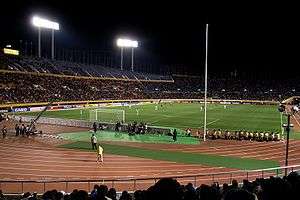
In August 2001, América won the CONCACAF Giants Cup after defeating MLS club D.C. United 2–0.[54] The following year, América would reach the league final against Necaxa, winning by a 3–2 aggregate score. After losing in the first-leg 0–2, América won the second by the same scoreline, forcing extra-time to be played. A golden goal from a Hugo Norberto Castillo header in the 107th minute gave América the victory, and the club its first league championship in 13 years.[55]
The club once again reached the league final during the Clausura 2005 tournament, finishing third in the standings and defeating Santos Laguna and Cruz Azul in the quarterfinals and semi-finals to face Tecos UAG. After a 1–1 draw in the first-leg, América was victorious in the second, winning the match 6–3 at the Estadio Azteca – 7–4 on aggregate – to win the club's tenth league title.[56]
On 19 April 2006, América defeated fellow-Mexican side Toluca to win the CONCACAF Champions' Cup, thus qualifying for the FIFA Club World Cup that same year.[57] At the tournament, América won its first match against Jeonbuk Hyundai Motors of South Korea. América went on to lose the next match against Spanish side FC Barcelona. It ended its participation in the tournament, losing the match for third place to Al Ahly of Egypt.[58]
2007
After the Club World Cup, América qualified for the playoffs of the Clausura 2007 defeating Atlas and Guadalajara in the quarter and semi-finals. They played the final against Pachuca, finishing runners-up.[59]
For the Apertura 2007, after starting off the season on a poor run, Luis Fernando Tena was sacked,[60] and was replaced by Daniel Brailovsky.[61] After finishing third in their group and sixth in the general standings, América played Morelia for the last spot in the playoffs, being beaten 3–0 in the first-leg, and winning 1–0 in the second-leg. With this, América was eliminated from the competition.[62]
América also participated in the Copa Sudamericana, reaching the finals to play against Arsenal de Sarandí of Argentina. They would lose the first-leg at the Estadio Azteca by a 2–3 score, and win 2–1 in Argentina. The aggregate result was 4–4, but due to the away goals rule, Arsenal won the championship.[63]
América finished 2007 ranked tenth in the IFFHS's Club World Rankings, becoming the first Mexican club to reach the top ten.[64][65][66]
2008
América started off 2008 winning the InterLiga tournament, defeating Cruz Azul 5–3 on penalties in the final following a 3–3 draw after 120 minutes, thus assuring qualification to the Copa Libertadores tournament that same year.[67]
The Clausura tournament saw América end in next-to-last place in the general standings. This had not been seen since the mid-1950s. In the first five months of 2008, América was showered with twelve defeats, two draws and three victories, which resulted in the third-straight tournament without qualifying for the playoffs. The manager at the time was Rubén Omar Romano, who was one of the least successful coaches in the club's history.[68] Coincidently, after being replaced by Juan Antonio Luna,[69] América got their third victory of the Clausura against Monterrey. Despite their poor domestic form, América fared well in the Copa Libertadores, defeating Brazilian side Flamengo 3–0 in the round-of-16 at the Estádio do Maracanã, overturning a 2–4 first-leg deficit, and advancing to the quarter-finals.[70] They defeated Santos FC to reach the semifinal stage of the tournament, being eliminated by eventual champions LDU Quito after drawing 1–1 on aggregate.
2010s
For the Apertura 2010, América brought back former manager Manuel Lapuente, who led the club to the league title in 2002.[71] The return of striker Vicente Matías Vuoso and the signing of Uruguayan Vicente Sánchez gave América one of the most dangerous front lines in all of the league.[72][73] They finished the tournament in first place of Group 2, fourth in the general standings, with 27 points. With this, they would advance to the playoffs, and automatically qualify for the first time since 2008, for the 2011 Copa Libertadores. They would be eliminated in the semi-finals by Santos Laguna by a 4–5 aggragate score.[74]
América had a bad start to the Clausura 2011 tournament; a 0–2–1 record in the first three games the tournament led to the sacking of Lapuente.[75] Carlos Reinoso was named his successor,[76] who had already managed the club two times before. His first game was against Atlas, which América won 2–0.[77] América ended the Clausura with an 8–1–5 record, and would be eliminated in the quarter-finals by Morelia.[78] On 18 September 2011, Reinoso was sacked as manager,[79] with Alfredo Tena taking over as interim-manager. América would finish the Apertura in 17th place, the second worse finish in the club's history. On 8 November, Michel Bauer stepped down as President.[80] That same day, former América player Ricardo Peláez was presented as Sporting President, while Yon De Luisa would be named Operations President.[81] Miguel Herrera was presented as the club's new manager, the fourth in a year.[82] In his first year at the helm, Herrera brought the team to the semi-finals on two consecutive occasions.
On 26 May 2013, América won their eleventh league title by defeating Cruz Azul in the Clausura final 4–2 on penalties after a dramatic comeback from a 0–1 first-leg loss to win 2–1 in the second-leg, and tie 2–2 on aggregate, with goalkeeper Moisés Muñoz scoring the second goal in injury-time.[83][84][85][86][87] With this, América tied Guadalajara for most league titles.[88] For the Apertura 2013, América finished the regular phase of the tournament at the top of the standings with 37 points and would again appear in the league final, though failing to achieve a repeat, being defeated by León by an aggregate score of 1–5.[89] On 17 December 2013, Antonio Mohamed was announced as América's new manager for the Clausura 2014 tournament, replacing Miguel Herrera after two years in charge.[90] América would finish fifth in the standings, and was eliminated in the quarter-finals by Santos Laguna due to the away-goals rule after drawing 6–6 on aggregate.[91]
América finished the Apertura 2014 tournament at the top of the general standings with 31 points, and defeated UNAM and Monterrey in the quarter-finals and semi-finals, respectively.[92] Prior to the league final, the club was marred with controversy, such as media speculation regarding the future of Antonio Mohamed (he ultimately admitted he would leave the club after the final), and the separation of Paul Aguilar from the team before playing the first-leg of the semi-finals.[93] On 14 December, América won a record-twelfth league title after defeating Tigres UANL 3–1 on aggregate in the final, coming back from a 0–1 first-leg loss to win 3–0 in the second-leg at the Estadio Azteca.[94][95][96][97] Three days after winning the final, América announced Gustavo Matosas as Mohamed's successor, signing a two-year contract.[98]
In April 2015, the club won its sixth CONCACAF Champions League title after defeating Montreal Impact in the finals by a 5–3 aggregate score.[99] Despite an inconsistent campaign throughout the Clausura tournament, América managed to finish second in the standings, though was eliminated by Pachuca in the quarter-finals.[100] Three days later, with various media reports suggesting Gustavo Matosas would be sacked due to differences with the board regarding player acquisitions and departures,[101] it was confirmed in a press conference which was attended by both Matosas and club president Ricardo Pelaéz that he would indeed leave after only six months in charge.[102] On 26 May, Ignacio Ambríz was presented as the new manager, signing a two-year contract.[103] América lost its FIFA Club World Cup quarter-final match to Chinese team Guangzhou Evergrande, and defeated African club TP Mazembe to claim fifth place in the competition.[104]
In April 2016, América successfully defended the CONCACAF Champions League title after defeating Tigres UANL 4–1 on aggregate in the finals, and winning a record seventh continental title.[105] América culminated the year with a fourth-place finish at the Club World Cup[106] and finishing runners-up in the Apertura championship match against Tigres UANL.[107]
América won its record thirteenth league title following a 2–0 aggregate victory over Cruz Azul in the 2018 Apertura final.[108] In April 2019, América defeated Ascenso MX side FC Juárez in the final of the Clausura edition of the Copa MX, winning a record sixth title.[109] In winning the cup, América became the outright record holders of the Liga MX, Copa MX, and CONCACAF Champions League.[110]
Crest and colors
Crest
| Wikimedia Commons has media related to Club América kits. |
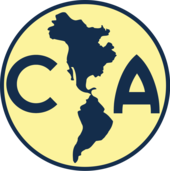
When Club América was founded in 1916, the crest consisted of the letter 'C', standing for "Club", overlapped by an 'A', which stood for "América".[111] After a brief period in which the team's name was changed to Club Unión, it was reverted to Club América in the mid-1920s, and the crest was modified, with a map of the Americas behind the 'CA', and encased in a football, all in the team's colors – which were cream and blue.[112][113] Since then, the design of the crest has seen minimal change; at the beginning of the 21st century, the vertical line at the crest's center was removed. During the early 1980s, the crest was surrounded by an image of an eagle (due to the club's nickname), and was even enclosed in a triangle.[112] The most recent modification of the crest was in 2010, with the yellow and blue more vibrant and a darker outline and border.[114]
Colors
Club founder Rafael Garza Gutiérrez chose what would be América's first uniform. He took some of his father's navy blue trousers and a yellow-cream shirt and it was decided amongst the other players that those would be the club's colors.[17] The club's kit design would go largely unchanged, and it would not be until the 1980s that the team colors changed, with the cream color replaced with a more vibrant yellow and blue, along with the introduction of the inverted triangle design on the shirt in 1982. A third, alternate white and blue shirt was introduced towards the end of the decade, but it was not worn frequently.[115]
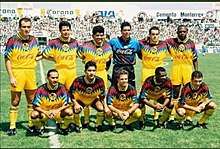
During the Apertura 2011 tournament – what would be the club's 95th anniversary – a commemorative jersey was unveiled paying homage to the original uniform, as well as an altered crest. The uniform was used during the Súper Clásico match against Guadalajara.[117]
In May 2016, as part of the club's centenary, a dark red away kit was revealed honouring Italian club Torino, who functioned as the club's first opponent at the Estadio Azteca in the 1966 inaugural match.[118][119]
Nicknames
The football club has often had many nicknames throughout its history, some used by the club and others given for different reasons. These are some of them:
• The Students: This was a nickname that wasn't well known and only used in the early years of the club. When the team was first founded, this nickname was used by their rivals because the team was developed from the combination of two colleges: Mascarones and La Perpetua.[120] Because many of their players were college students, when Club America joined La Liga Mexicana (the Mexican Soccer League), it was composed mostly of young players.
• The Blue-Creams or Creams: This nickname was one of the more distinctive and oldest nicknames. Used since 1920, it is the reason the club used the colorways it did. Back then, the jerseys were a cream color while the shorts and socks were blue.
• Canaries: This was one of the nicknames they have been known as since the 1940s. This was given to them because of the yellow found in the uniform.
• Millionaires: This is a derogatory reference or version of the word millionaire. It started when businessman Emilio Azcarraga Milmo bought the team in 1959.[121] Azcarraga hired the successful president of the Club Zacatepec, Guillermo Cañedo de la Bárcena, and started to hire other notable foreigner figures, focusing on money, to form a powerful team.[122]
• Eagles: Although this emblem of the eagle had appeared briefly in one version of the club shield in the 1940s, it wasn't a popular nickname until the arrival of new club America President Emilio Díez Barroso in the early 1980s. With the club looking for a new image, they wanted to have a representation of an animal that would show pride and domination of its environment. Supported by a strong campaign, they chose the eagles. This nickname remains popular to this day.
Grounds

América plays its home games at the Estadio Azteca in Mexico City. The stadium was designed by Mexican architect Pedro Ramírez Vázquez, and was inaugurated on 29 May 1966 with a match between América and Torino, which was tied 2–2. The first goal was scored was by Brazilian Arlindo Dos Santos and the second by José Alves.[123] Gustavo Díaz Ordaz, President of Mexico, made the initial kick and Sir Stanley Rous, FIFA President, was the witness.
The club has shared the stadium as a home ground with the Mexico national football team since its inauguration. Other club sides have also used the stadium as their home at different times, namely Necaxa (1966–70 and 1982–2003), Atlante (1966–82, 1996–2001 and 2004–2007), Universidad Nacional (1967–1969), Atlético Español (1970–1982) and Cruz Azul (1971–1996).
As well as acting as a home ground the stadium has also hosted the 1968 Summer Olympics, 1970 FIFA World Cup, 1975 Pan American Games, 1983 FIFA World Youth Championship, 1986 FIFA World Cup, 1999 FIFA Confederations Cup, 2011 FIFA U-17 World Cup Final, Copa Interamericana, Copa Libertadores de América, music concerts, political events and the visit of Pope John Paul II in 1999.[124]
Rivalries
El Super Clásico
Clásico Capitalino
The rivalry between Club América and Club Universidad Nacional is known as the "Clásico Capitalino",[125] due to the fact that both teams are based in Mexico City—the country's capital. The first match between the two clubs took place on 1 July 1962, where América hosted UNAM, who had recently been promoted from the second division. In Mexico the match is often perceived as the representation of a struggle between two antagonistic powers and institutions: Club América is regarded as the club representing the establishment and the wealthy. The fact that the club is owned by the mass media company Televisa has further intensified this image. Club Universidad, representing the Universidad Nacional Autónoma de México, identifies itself as the club of the intellectuals and middle-class.[126] The rivalry is particularly fierce from UNAM's side: according to surveys the majority of their supporters consider América as their main rival. However, America's fans see it as an important match but deem the match against Chivas as more important.[127]
Clásico Joven
Club América's other capital-based rival is Cruz Azul, with whom they compete in the derby known as the "Clásico Joven" (Juvenile Classic in Spanish).[125] Although both teams reside in Mexico City, Cruz Azul originated in Jasso, Hidalgo. In a similar perspective between América and UNAM's rivalry, the rivalry between América and Cruz Azul is also seen as based on social class differences: América representing the wealthy and powerful while Cruz Azul is said to represent the working class,[128] hence fans of Cruz Azul and the team itself being dubiously referred to by the nickname of "Los Albañiles" (bricklayers in Spanish), a reference to Cruz Azul's eponymous parent company, which is one of Mexico's major companies specializing in concrete and construction.
Support
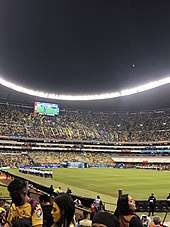
Ever since América was bought by Emilio Azcárraga Milmo from Issac Bessudo in 1959, the club has had the unique distinction of being both one of the most popular clubs in Mexico, as well as the most hated.[129] An emphasis on heavy spending on Mexican and foreign players and managers in subsequent seasons, as well as success in domestic and international competitions, created an increasing sense of enmity from rival fans. The fact that Azcárraga Milmo was also the owner of telecommunications company Telesistema Mexicano furthered the notion that América was the club of the "establishment" and the "wealthy", while others were considered teams representing the "working class".[128]
In December 2013 Mexican newspaper Reforma had América as the country's most popular club with 25 percent in a nationwide survey, and the most popular club in Mexico City. They were also voted the most hated club in the same survey with 41 percent of the votes.[130][131] According to a February 2015 poll conducted by Mexican pollster Consulta Mitofsky, América is Mexico's most popular football club with 31.1 percent, and the most hated with 41.5 percent.[132][133][134] According to a study conducted by consulting agency EuroAmericas Sports Marketing, América is the most popular Mexican club in Asia, and the third most popular from the Americas after Corinthians of Brazil and Boca Juniors of Argentina.[135]
Being reputed as the most-hated club in the country has been embraced by the club and its fans, with the phrase "Ódiame Más" – or "Hate me more" in English – being known as one of the team's unofficial slogans.[136]
América has the highest attendance numbers in Mexico and the eighth most in the world.[137]
Sponsorship
Personnel
Management
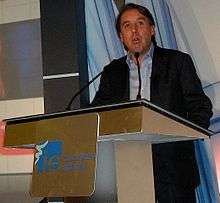
| Position | Staff |
|---|---|
| Chairman | Emilio Azcárraga Jean |
| Honorary counsel | Bernardo Gómez Martínez |
| Sporting president | Santiago Baños |
| Director of operations | Vacant |
| Coordinator of strategic planning | Miguel Ángel Garza |
| Academy director | Alfredo Tena |
| Academy operations coordinator | Carlos Valenzuela |
| Director of communications and marketing | Quentin Paquelier |
| Director of public relations | Karina Mora |
Source: Club América
Coaching staff
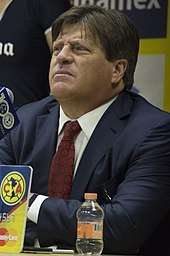
| Position | Staff |
|---|---|
| Manager | |
| Assistant managers | |
| Goalkeeper coach | |
| Fitness coaches | |
| Physiotherapists | |
| Team doctors | |
Source: Club América
Players
First-team squad
Note: Flags indicate national team as defined under FIFA eligibility rules. Players may hold more than one non-FIFA nationality.
|
|
Out on loan
|
|
Reserve teams
Notable players
Historic players
As part of Club América's centenary celebrations in 2016, a public vote was taken via the club's website in which the following players were chosen as 'Historic Players'. Players whose names appear italicized played for the club at the time the votes were taken.
- Goalkeepers[146]
- Defenders[147]





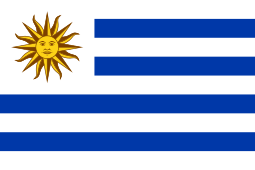



- Midfielders[148]









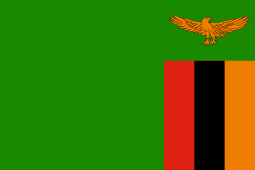
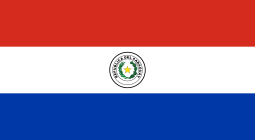

- Forwards[149]
Player records
Top scorers
|
|
All-time records
|
|
Managers
Notable managers
The following managers have won at least one trophy while in charge at América:
| Manager | Period | Trophies |
|---|---|---|
| 1917–19, 1920–26, 1929–31, 1933–35, 1935–36, 1937–42, 1946–49 | Primera División (2): 1924–25, 1925–26 | |
| 1926–29 | Primera Fuerza (2): 1926–27, 1927–28 | |
| 1949–50, 1952–55 | Copa México (2): 1953–54, 1954–55; Campeón de Campeones (1): 1954–55 | |
| 1964–65 | Copa México (2): 1963–64, 1964–65 | |
| 1965–66 | Primera División (1): 1965–66 | |
| 1971–75 | Primera División (1): 1970–71; Copa México (1): 1973–74 | |
| 1975–78 | Primera División (1): 1975–76; Campeón de Campeones (1): 1975–76; CONCACAF Champions' Cup (1): 1977; Copa Interamericana (1): 1977 | |
| 1981–84, 1998, 2011 | Primera División (2): 1983–84, 1984–85 | |
| 1985–87 | Primera División (1): Prode-85; CONCACAF Champions' Cup (2): 1987, 1992 | |
| 1987–89 | Primera División (2): 1987–88, 1988–89; Campéon de Campeónes (2): 1987–88, 1988–89 | |
| 1990–91 | CONCACAF Champions' Cup (1): 1990, Copa Interamericana (1): 1991 | |
| 2000–01 | CONCACAF Giants Cup (1): 2001 | |
| 2001–02, 2002–03, 2006, 2010–11 | Primera División (1): Verano 2002; CONCACAF Champions' Cup (1): 2006 | |
| 2004–05 | Primera División (1): Clausura 2005; Campeón de Campeones (1): 2004–05 | |
| 2012–13, 2017– | Liga MX (2): Clausura 2013, Apertura 2018; Copa MX (1): Clausura 2019; Campeón de Campeones (1): 2019 | |
| 2014 | Liga MX (1): Apertura 2014 | |
| 2015 | CONCACAF Champions League (1): 2014–15 | |
| 2015–2016 | CONCACAF Champions League (1): 2015–16 |
Presidents
Since the club was established in 1916, América has had 27 club presidents, with the first being Florencio Domínguez, who served from 1916 to 1920. Guillermo Cañedo de la Bácerna is the club's longest-serving president who served from 1961 to 1981. Filiberto Zapata had the shortest term in the club's history – serving less than year – in 1940. The current sporting president is Santiago Baños.[152]
In 1951, actor and comedian Cantinflas was named Honorary President of the Club.[153]
| Name | From | To |
|---|---|---|
| 1916 | 1920 | |
| 1920 | 1930 | |
| 1930 | 1932 | |
| 1933 | 1933 | |
| 1933 | 1934 | |
| 1934 | 1937 | |
| 1937 | 1938 | |
| 1938 | 1939 | |
| 1939 | 1940 | |
| 1940 | 1940 | |
| 1940 | 1945 | |
| 1945 | 1948 | |
| 1948 | 1949 | |
| 1950 | 1954 | |
| 1954 | 1956 | |
| 1956 | 1959 | |
| 1959 | 1961 | |
| 1961 | 1981 | |
| 1981 | 1996 | |
| 1996 | 1997 | |
| 1997 | 1998 | |
| 1998 | 1999 | |
| 1999 | 2004 | |
| 2004 | 2008 | |
| 2008 | 2011 | |
| 2011 | 2017 | |
| 2017 |
Honours
América is the most successful and most decorated club in Mexican football history.[154] The club has won 13 league titles,[155] 6 Copa México championships, and 6 Campeón de Campeones cups. They hold the record for most league and cup titles,[110] and their Campeón de Campeones wins are second only to rival Guadalajara's 7 titles.[156] In international competitions, América has won 10 titles, the most for a club from the CONCACAF region.[16] The club has won a record 7 CONCACAF Champions' Cup/Champions League titles,[157] 2 Copa Interamericana cups (the most among Mexican clubs), and 1 CONCACAF Giants Cup.[158]
Domestic
League
- Primera División / Liga MX
- Winners (13): 1965–66, 1970–71, 1975–76, 1983–84, 1984–85, Prode-1985, 1987–88, 1988–89, Verano 2002, Clausura 2005, Clausura 2013, Apertura 2014, Apertura 2018 (record)
Cups
- Copa México / Copa MX
- Winners (6): 1953–54, 1954–55, 1963–64, 1964–65, 1973–74, Clausura 2019 (record)
- Campeón de Campeones
International
- CONCACAF Champions' Cup / CONCACAF Champions League
- Copa Interamericana
- CONCACAF Giants Cup
- Winners (1): 2001 (record)
International competitions
|
|
References
- "América". LigaMX.net.
- "La historia de las Águilas del América". Club América – Sitio Oficial. 20 September 2019.
- "Los "apodos" del América en sus 96 años". Pulso. Archived from the original on 30 April 2014. Retrieved 12 October 2012.
- "2026 FIFA World Cup Bid Book" (PDF). p. 161. Retrieved 5 April 2018.
- "Grupo Televisa, S.A.B." Internet Securities, Inc. Euromoney Institutional Investor company. Retrieved 20 July 2011.
- "El Azteca, cuna de campeones (The Azteca, home of champions)". FIFA. 29 March 2011. Retrieved 25 April 2011.
- "The 10 Largest Football Stadiums in the World". Soccerlens. Retrieved 24 November 2009.
- "Top Ten Biggest Soccer Stadiums in the World". Sportige. Retrieved 4 October 2011.
- "Coventric!". RSSSF.com. Rec.Sport.Soccer Statistics Foundation. Retrieved 24 June 2015.
- "Mexico's Clásico de Clásicos". FIFA.com. Retrieved 1 April 2010.
- "FourFourTwo's 50 Biggest Derbies in the World: 20-11". FourFourTwo. FourFourTwo. Retrieved 17 July 2016.
- Mewis, Joe. "The top 50 football derbies on the world 20-11: Italian and Brazilian rivalries plus 'the Mother of all Battles'". mirror.co.uk. Mirror. Retrieved 13 April 2018.
- "Top 10 club rivalries in world soccer". Sports Illustrated. Retrieved 21 April 2017.
- "América: 100 years of Mexico's bad guys". FIFA.com. Retrieved 12 October 2016.
- Gorozpe, Carlos. "América es el equipo de la Concacaf con más títulos internacionales". Diario Récord. Retrieved 12 October 2011.
- Dávalos, Juan Antonio. "América, club mexicano con más títulos internacionales". El Universal. Retrieved 4 December 2007.
- "Primer uniforme del Club América". Club América – Sitio Oficial.
- "Inicia la aventura (1917–1942)." Archived 4 January 2005 at the Wayback Machine www.esmas.com. Redaccion. (in Spanish)
- "¿Por qué el América dice tener 16 títulos del fútbol mexicano?". AS.com.mx. Retrieved 8 March 2018.
- "El primer campeonato de Liga". Club América – Sitio Oficial. Retrieved 1 March 2020.
- "América Campeón de Liga 1927–28". Club América –Sitio Oficial.
- "1931–1940". Club America – Sitio Oficial.
- "América Campeón de Copa 1953–54". Club América – Sitio Oficial.
- "Copa México 1954–1955: América vs Chivas". Club América – Sitio Oficial.
- "América campeón de campeones 1954–1955". Club América – Sitio Oficial.
- "Epoca profesional (1943–1969)." Archived 5 December 2004 at the Wayback Machine www.esmas.com. Redaccion. (in Spanish)
- "Centenario Club América: El Tigre los salvó – Capítulo 4". Futbol Total. Retrieved 6 October 2016.
- "América Campeón de Copa temporada 1963–1964". Club America – Sitio Oficial.
- "América derrotó a Morelia en la final de la Copa México 1964–1965". Club América – Sitio Oficial.
- "Partidos memorables América vs Toluca". Club América – Sitio Oficial.
- "América Campeón de Copa 73–74". Club América – Sitio Oficia.
- "América campeón de Liga 1975–76". Club América – Sitio Oficial. Archived from the original on 11 September 2014.
- "América Campeón de Campeones 1975-1976". Club América – Sitio Oficial.
- "América Campeón de la Copa Interamericana 1978". Club América – Sitio Oficial.
- "CONCACAF Retro: Club America wins first two international titles in 1978". Archived from the original on 17 March 2015. Retrieved 17 January 2014.
- Calderón, Carlos. "El América de los ochenta". Medio Tiempo. Retrieved 22 February 2009.
- "El primer bicampeonato americanista en la era profesional". Club América – Sitio Oficial.
- "El segundo bicampeonato americanista en la era profesional". Club América – Sitio Oficial.
- "América campeón de campeones 87–88". Club América – Sitio Oficial.
- Martínez, Enrique. "La Final del Siglo fue para el América". Diario Récord. Retrieved 23 September 2015.
- "El clásico más importante: Final del siglo América 3–1 Chivas 1983–1984". Club América – Sitio Oficial.
- "Las tres finales en que América y Chivas se han visto las caras". Diario AS. Retrieved 24 September 2015.
- "Club América vs Pumas – Gran Final 1985 América Campeón". Club América – Sitio Oficial.
- "A 30 años del temblor del 85 y lo que pasó en el deporte en México". ESPN Deportes. Retrieved 19 September 2015.
- "Nace el tricampeón; torneo Prode 85". Excélsior. Retrieved 6 October 2016.
- "América campeón de Liga 87–88". Club America – Sitio Oficial.
- "América cerró su época gloriosa de los 80s derrotando a Cruz Azul en la final de 1989". Univision. Archived from the original on 14 July 2014. Retrieved 23 May 2013.
- "América campeón del torneo de la CONCACAF 1990–1991". Club América – Sitio Oficial.
- "Copa Interamericana – Historial". Universo Fútbol.
- "América Campeón de CONCACAF 1992–93". Club América – Sitio Oficial.
- "Leo Beenhakker reveló por qué salió del América". Medio Tiempo. Retrieved 16 March 2010.
- "Leo Beenhakker no consiguió hacer realidad el sueño de sacar campeón al América". Térra Networks. Retrieved 24 November 2003.
- "México y la Libertadores, 15 años de historia". Publisport. Archived from the original on 13 April 2013. Retrieved 4 February 2013.
- "Club America Wins Giants Cup". Los Angeles Times. Retrieved 6 August 2001.
- "América campeón Verano 2002". Club América – Sitio Oficial.
- "América Campeón del Clausura 2005". Club América – Sitio Oficial.
- "América Campeón de CONCACAF 2006". Club América – Sitio Oficial.
- "2006 FIFA Club World Cup – Overview". FIFA.
- "Pachuca, campeón del futbol mexicano". El Universal. Retrieved 27 May 2007.
- "Se va Luis Fernando Tena del América". Orizabaenred.com.mx. Retrieved October 7, 2007.
- ""Ruso" Brailovsky es nuevo técnico del América de México". nacion.com. Retrieved 8 October 2007.
- "Morelia elimina a un grande". El Siglo de Torreón. Retrieved 19 November 2007.
- "Arsenal, campeón de la Sudamericana". Página/12. Retrieved 6 December 2007.
- "Club World Rankings 2007". International Football Federation of History and Statistics.
- "América, décimo mejor club del 2007: IFFHS". Caracol. Archived from the original on 25 May 2013.
- "América, décimo en la clasificación mundial de la IFFHS". orizabaenred.com.mx. Retrieved 31 December 2007.
- "América gana la Interliga y va a la Libertadores". adnmundo.com. Adnmundo. Archived from the original on 18 January 2008. Retrieved 13 January 2008.
- Dávalos, Juan Antonio. "Los 10 datos para el olvido de Romano con América". El Universal. Retrieved 1 May 2008.
- Davalos, Parra, Juan Antonio, José Ángel. "Juan Antonio Luna es el nuevo técnico del América". El Universal. Retrieved 30 April 2008.
- "América dio un maracanazo; 3–0 al Flamengo y avanzó". La Jornada. Retrieved 7 May 2008.
- "Manuel Lapuente es el nuevo técnico del América de México". FutbolRed. Retrieved 25 May 2011.
- "Matías Vuoso regresa al América". El Economista. Retrieved 27 May 2010.
- "America Bring Vicente Sanchez Back To Mexico". Goal.com. Retrieved 7 July 2010.
- Cañada, Iván. "Santos elimina al América y está en la Final". Récord. Archived from the original on 12 June 2013. Retrieved 28 November 2010.
- "Club America Fire Manager Manuel Lapuente". SBNation. Retrieved 25 January 2011.
- "America sack Lapuente, bring Reinoso". Goal. Archived from the original on 11 July 2011.
- "Carlos Reinoso debuta y gana: América vence 2–0 a Atlas". Publimetro. Retrieved 30 January 2011.
- McCauley, Kevin. "Monarcas Morelia Vs. Club America, 2011 Liguilla: 3–2 Full Time, Super Eagles Out". SBNation. Retrieved 9 May 2011.
- "Queda Reinoso fuera del América". Televisa Deportes. Retrieved 18 September 2011.
- "Michel Bauer quedó fuera del América". La Jornada. Retrieved 8 November 2011.
- "Ricardo Peláez, nuevo Presidente Deportivo del América". Diario Récord. Retrieved 11 November 2012.
- "Miguel Herrera es el técnico del América". ESPN Deportes. Retrieved 16 November 2011.
- "¡América Campeón de la Liga MX!". Club América – Sitio Oficial. Retrieved 26 May 2013.
- Vertelney, Seth. "America win Liga MX Clausura title". Goal. Retrieved 27 May 2013.
- Terán, Juan Manuel. "¡América, Campeón del Clausura 2013!". Medio Tiempo. Retrieved 27 May 2013.
- Mulroy, Peter J. (26 May 2013). "America Vs. Cruz Azul: Second Leg of 2013 Mexican Clausura Championship Ends With Shootout As America Outlasts Cruz In Epic Finale; Recap". Latin Times. Retrieved 27 May 2013.
- "América es campeón del Torneo Clausura 2013 de LigaMX". Noticiero Televisa. Retrieved 27 May 2013.
- Marshall, Tom. "America title a reminder that Chivas have much to do". ESPN FC. Retrieved 28 May 2013.
- McCarthy, Kyle. "Club Leon win sixth Primera title". Fox Sports. Retrieved 16 December 2013.
- "Mohamed presentado como nuevo técnico americanista". Club América – Sitio Oficial. Retrieved 17 December 2013.
- Ruiz, Alberto (3 May 2014). "Santos completó el milagro y va a Semis". Medio Tiempo. Retrieved 3 May 2014.
- "El camino del campeón: América". La Afición. Retrieved 14 December 2014.
- "America coach Mohamed separates Aguilar from squad". Goal. Retrieved 6 December 2014.
- "Cronica: América Campeón". Club América – Sitio Oficial. Retrieved 14 December 2014.
- "América vence 3–1 a Tigres y obtiene el décimosegundo título". ESPN Deportes. Retrieved 14 December 2014.
- "América conquista la liga de México tras derrotar a Tigres". Diario AS. Retrieved 16 December 2014.
- "Club America captures Liga MX crown with conquest of Tigres". NBC Sports. 15 December 2014. Retrieved 16 December 2014.
- "Gustavo Matosas es el nuevo D.T. Águila". Club América – Sitio Oficial. Archived from the original on 17 December 2014. Retrieved 17 December 2014.
- Logotheti, Paul (29 April 2015). "Club America beats Montreal Impact, claims CONCACAF Champions League title". USA Today. Retrieved 30 April 2015.
- "América eliminado por el Pachuca". El Diario. Retrieved 16 May 2015.
- Cañada, Iván (18 May 2015). "Relación entre Gustavo Matosas y América pende de un hilo". ESPN Deportes. Retrieved 19 May 2015.
- "Matosas, fuera del América". Medio Tiempo. Retrieved 19 May 2015.
- "Ignacio Ambriz presentado como nuevo técnico del Club América". Club América – Sitio Oficial. Retrieved 26 May 2015.
- "Club América claim fifth place". FIFA.com. Retrieved 16 December 2015.
- "Cronica: América 2-1 Tigres". Club América – Sitio Oficial. Retrieved 28 April 2016.
- "América es cuarto lugar en el Mundial de Clubes". La Afición. Grupo Milenio. Retrieved 18 December 2016.
- "En agónico partido, Tigres vence a América en penales". ESPN Deportes. Retrieved 25 December 2016.
- Tolmich, Ryan. "Club America top Cruz Azul to claim Liga MX Apertura crown". Goal.com. Retrieved 16 December 2018.
- "América es campeón de Copa MX tras vencer a FC Juárez". Milenio. Retrieved 11 April 2019.
- "América se convierte en máximo ganador de copa; ya lo era de liga y Concacaf" (in Spanish). ESPN Deportes. Retrieved 11 April 2019.
- "El primer escudo del Club América". Club América – Sitio Oficial. Retrieved 25 February 2013.
- "La evolución del escudo del América". Publimetro. Retrieved 12 October 2013.
- "El segundo y más emblemático escudo del Club América". Club América – Sitio Oficial. Retrieved 20 March 2013.
- "El actual escudo del Club América". Club América – Sitio Oficial. Retrieved 23 October 2013.
- "Uniformes de América con V". Club América – Sitio Oficial. Retrieved 11 June 2013.
- "FourFourTwo's 50 best football shirts... EVER". FourFourTwo. Retrieved 9 October 2019.
- "América lanza uniforme conmemorativo". Medio Tiempo. Retrieved 7 October 2011.
- "El nuevo jersey Club América 2016". Club América – Sitio Oficial. Retrieved 26 May 2016.
- "Stunning Club America 2016 Centenary Kits Revealed". Footy Headlines. Retrieved 26 May 2016.
- "Historia * Club América - Sitio Oficial". Club América - Sitio Oficial (in Spanish). Retrieved 7 March 2017.
- FIFA.com (21 May 2008). "America, 100 years of Mexico's bad guys". FIFA.com. Retrieved 7 March 2017.
- Liz, Crolley; M., Miller, Rory (1 January 2007). Football in the Americas : fútbol, futebol, soccer. Institute for the Study of the Americas. ISBN 9781900039802. OCLC 473907754.
- "El Azteca". Club América – Sitio Oficial. Archived from the original on 15 February 2014.
- "Pide Juan Pablo II "superar" deficiencias en el progreso social". Retrieved 12 October 2007.
- "Encuesta completa sobre el equipo más popular de México". Univision.com. Grupo Reforma. 2007. Archived from the original on 12 October 2007. Retrieved 2008. Check date values in:
|accessdate=(help) - "FIFA Classic Rivalries: CF América VS Pumas UNAM – Mexico City's grudge game". FIFA.com.
- Eduardo Hernández Castro (2003). "Para Pumas la vida; para América, no lo es todo". El Economista. Retrieved 21 April 2013.
- Archibold, Randal C. (25 October 2013). "Mexican Writer Mines the Soccer Field for Metaphors". The New York Times. Retrieved 26 October 2013.
With Cruz Azul and América taking to the field on the television behind him at the cantina, Mr. Villoro sought to put the game, a traditional matchup between dominant teams in the capital, in context. "This is the Mexico City classic," he explained. "The game itself is one thing, who scores, who wins. But Cruz Azul represents the working class here; that is their following. América is the upper class, the rich or wannabe rich. So this condenses into the workers versus the wannabes."
- García, Miguel Ángel."Ódiame cuando quieras" Archived 16 January 2014 at the Wayback Machine. La Cuidad Deportiva. Retrieved May 28, 2013.
- "América el equipo más popular de México". Club América –Sitio Oficial. Retrieved 12 December 2013.
- "Son favoritos América y Léon". Encuestas Grupo Reforma. Retrieved 3 January 2014.
- "América, el equipo más popular de México". Diario Récord. Retrieved 10 February 2015.
- "América tiene más seguidores que Chivas y Cruz Azul juntos". EconomíaHoy. Retrieved 10 February 2015.
- "El más popular de México". Club América – Sitio Oficial. Retrieved 10 February 2015.
- Price, Daniel (20 November 2014). "Club America, Corinthians and Boca Juniors Are The Most Popular Teams in Asia". Caughtoffside. Retrieved 20 November 2014.
- French, Scott. "Fandom taken to a different level at Club America". ESPN. Retrieved 28 April 2010.
- "2011–12 World Football Attendances – Best Drawing Leagues (Chart of Top-20-drawing national leagues of association football) / Plus list of 35-highest drawing association football clubs in the world in 2011–12".
- "Guía de medios" (PDF). Club América – Sitio Oficial. Archived from the original (PDF) on 28 September 2015.
- Campos, Alan. "Los grandes del patrocinio". Merca2.0. Retrieved 16 July 2013.
- "Club América - Caliente.MX". Caliente.mx. Retrieved 1 August 2020.
- "América y Pumas anuncian nuevo patrocinador para la Copa por México". Medio Tiempo. Retrieved 2 July 2020.
- "Club America – StubHub". StubHub.com.
- "Bienvenido TOTAL". Club América – Sitio Oficial.
- "Plantilla". Club América – Sitió Oficial.
- "Squad". Liga MX.net.
- "Homenaje a porteros históricos de América * Club América - Sitio Official". Club América - Sitio Oficial (in Spanish). 15 July 2016. Retrieved 9 March 2017.
- "Homenaje a los defensas históricos del América * Club América - Sitio Oficial". Club América - Sitio Oficial (in Spanish). 31 July 2016. Retrieved 9 March 2017.
- "Homenaje a mediocampistas históricos Azulcremas * Club América - Sitio Oficial". Club América - Sitio Oficial (in Spanish). 18 September 2016. Retrieved 9 March 2017.
- "Estos son los delanteros históricos elegidos por nuestra afición * Club América - Sitio Oficial". Club América - Sitio Oficial (in Spanish). 5 October 2016. Retrieved 9 March 2017.
- "Máximos Goleadores en la Historia". Realidadamericanista.com. Archived from the original on 22 November 2014. Retrieved 27 July 2008.
- "Anexos: Jugadores con más partidos jugados". Águilas del América: cronología de un equipo campeón. AM Editores S.A. de C.V. 2003. p. 183. ISBN 968-5336-35-0.
- "Presidentes del América".
- Rodríguez Canales, Edith (19 April 2008). "Quince años sin "Cantinflas"". Esto. Retrieved 21 April 2008.
- "¿Cuántos títulos tiene América en su historia?". Goal.com. Retrieved 24 May 2020.
- "Campeonatos del América". Club América – Sitio Oficial.
- "Chivas vs. América: ¿qué equipo tiene más títulos?". Goal.com. Retrieved 29 December 2019.
- "América cinco veces campeón de CONCACAF". Club América – Sitio Oficial.
- "La sala de trofeos americanista". Club América – Sitio Oficial.
Further reading
- "Anexos: Jugadores con más partidos jugados". Águilas del América: cronología de un equipo campeón. AM Editores S.A. de C.V. 2003. p. 183. ISBN 968-5336-35-0.
External links
| Wikimedia Commons has media related to Club América. |

